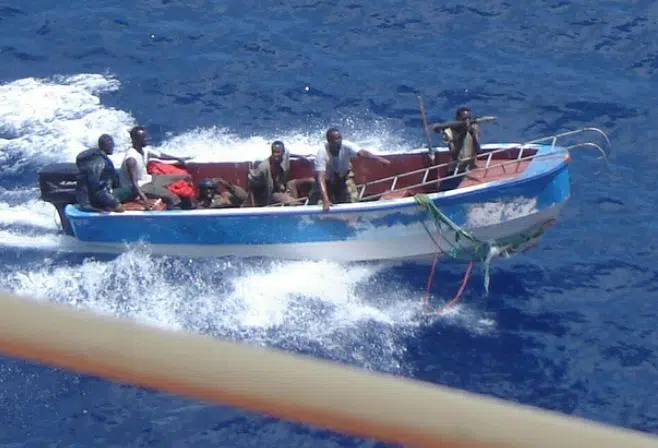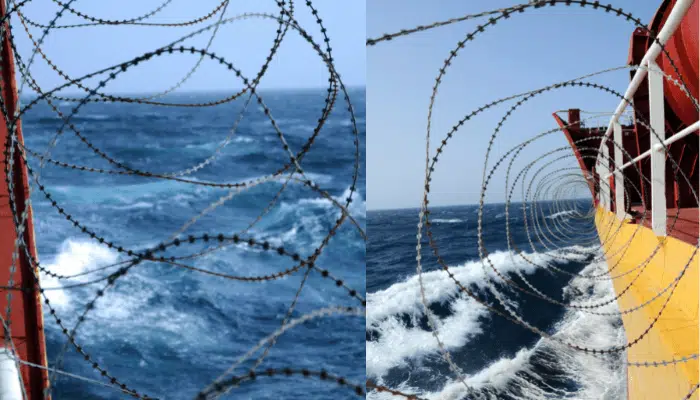10 Things to Consider Before Your Ship Enters Piracy Prone Area
While the number of piracy attacks along the coast of Somalia has decreased, there has been a substantial increase in piracy incidents along the coast of West Africa. As maritime organisations continue to bring in newer regulations and guidelines to protect ship from pirates, seafarers are also required to stay extremely cautious and vigilant when their ship enters a piracy sensitive area.
Mentioned are then things seafarers must do before entering piracy affected zone/ high risk areas.
1. Keep Yourself Updated with the Latest Happenings of the High Risk Areas
Get all the latest available information on piracy sensitive areas your ship is about to enter. Collect all the useful information on piracy activities from important maritime websites. Based on this information, carry out a thorough risk assessment of the vessel to assess the likelihood and consequences of piracy attacks.
The ship’s master is also required to prepare an Emergency Communication Plan to Include All Emergency Contact Numbers (provided at the end of the article) and prepared messages which should be ready at hand or permanently displayed near all external communication systems. All important warnings and information on high risk ares should be carefully reviewed.
2. Ship security Assessment and Plan: It is the duty of the company/ owner to review the SSA and SSP on a regular basis under the ISPS code. Company security Officer (CSO) must encourage ship personnel, especially Ship Security Officer (SSO) and master, to implement the SSP by exercising and briefing well ahead of ship passing high risk areas.
3. Take all Measures for Crew Safety
The safety of the ship’s crew is of prime importance. Ensure all measures are taken to prevent illegal boarding and external access to the ship’s accommodation area. The location of the muster station and citadel should be such that they are easily and quickly accessible by the ship’s crew. Care should also be taken to ensure that the crew members are not trapped inside and are able to escape in other emergency situations like fire.
As pirates usually fire at the bridge first to stop the vessel, proper ballistic protection must be provided to the ship’s crew on the bridge during piracy attack.
4. Check Ship’s Freeboard
As usually seen, pirates try to board the ship using the lowest point above the waterline as it is easy for them to climb. On the basis of past experience, it is said that the ships having a minimum freeboard greater than 8 meters have better chances of escaping a piracy attempt. However, it is to note that a large freeboard would not be of any help if the ship has easy access points to climb the ship. Special protective measures must be provided to these access points.
5. Prepare to Keep Ship’s Speed More Than 18 knots
Ship’s speed is considered one of the most effective ways to prevent a pirate attack. According to sources, there have been no reports of ships having more than 18 knots getting highjacked. As it is difficult for pirates to board at high speeds, ships are recommended to proceed at full speed or at least 18 knots during their transit through high risk area.
Refer to important websites such as NATO shipping center to get the latest information regarding pirate attack speed capability.

Note: Usually a pirate attack is carried out using small crafts which are supported by bigger vessels, also known as mother ships. This tends to restrict their operations to moderate sea state. Sea state 3 and above are difficult to operate small crafts. So keep the sea condition in mind while preparing for the piracy zone.
6. Keep Non-Lethal Weapons Ready
Keep all the non-lethal weapons handy and ensure they are in proper working condition. Crew members must know how to operate non-lethal weapons during emergency situations. Learn about different anti-piracy weapons used on ships.
Note: Several countries have started allowing armed guards on board ships to keep pirates away.
7. Check Fire Pumps and Engines
Check all fire pumps are working properly as they will be required to run fire hoses during pirate attacks. Also ensure that the engines are working properly as the ship will be required to transit at full speed through the high risk zone.
8. Brief Crew and Conduct Drill
Before entering high risk zone the ship’s crew should be properly briefed on the preparations taken and piracy drill should also be conducted. All personnel should know their duties and must be familiar with piracy alarms and necessary response for the same.
9. Secure Doors and Hatches
Doors and hatches providing access to bridge accommodation and machinery spaces should be properly secured to prevent pirates from them. If required additional means must to taken to properly secure doors and hatches for additional protection.
Prior to entering high risk areas, procedures for controlling access to accommodation, machinery spaces and store rooms should be set out and practiced.
10. Controlled and Restricted Entry: As discussed in the above point, it is important to secure different entry points in the ship, as it will be practically not possible to shut all for few entry/ exit points are required for watch and other important ship operations to continue. It must be ensured that any emergency exit cannot be opened by outside and if pirates do gain access to the upper deck of a vessel they will be tenacious in their efforts to gain access to the accommodation section and in particular, the bridge.
11. Use Physical Barriers If Available
If possible use physical barriers such as razor wires and electrified fence along the periphery of the ship to prevent pirates from boarding. Also keep water cannons, ballast / fire pumps, and fire hoses ready. Use all kind of barriers that are available to prevent pirates from boarding the ship.
Also, check if all the alarms and deck lights are working properly or not.
12. Check Ship’s AIS system, radar, and other important navigation equipment
Ensure that the ship’s AIS system and other important navigation equipment are working properly. It is recommended to keep the ship’s AIS system On while transiting the high risk zone. Ensure that the ship’s radar system is working properly. Also, the ship security plan and ship security alert system (SSAS) should also be checked.
13. Keep Communication ON: Communication is an important aspect to tackle any emergency operation, especially in piracy related situations. It is important that all the crew members keep an active communication throughout:
- All personnel on duty to carry a radio.
- VHF channel 16 (8) on the bridge and in safe room.
- Identify the relevant contact information that should be available on the bridge. This could include: MTO Dubai Hotline, own company, MSC-HOA, CJTF-HOF, Rescue sources, other ships and naval ships nearby
- Test of all communication equipment
The above mentioned points are some of the most important things that should be checked before the ship enters piracy zone. However, the precautions to be taken should also include factors such as type of ship, route, weather conditions etc. Do you think anything else also must be considered while entering high risk zone? Let us know in the comments below.
Important Contacts :
To Report of Somali piracy incidents only – please contact below immediately
UKMTO: Tel: +971 50 552 3215, Fax: +971 4 306 5710, Email: UKMTO@eim.ae
MSCHOA: Tel: +44 (0) 1923 958547, +44 (0) 1923 958700
Fax: +44 (0) 1923 958520, Email: postmaster@mschoa.org
NATO: Tel: +44 (0) 1923 956574, Fax: +44 (0) 1923 956575. Email: info@shipping.nato.int
|
MARLO (Maritime Liaison Office Bahrain) MARLO (24 Hours): |
: Tel: +973 1785 3925
Tel: +973 3940 1395 |
IMB PRC: Tel: +60 3 2031 0014, Fax: +60 3 2078 5769, Email: piracy@icc-ccs.org / imbkl@icc-ccs.org
To Report incidents on Piracy and Armed Robbery occurring anywhere else in the world please contact the IMB Piracy Reporting Centre:
Ships are advised to maintain strict anti-piracy watches and report all piratical attacks (actual and attempted) and suspicious sightings to the IMB Piracy Reporting Centre, Kuala Lumpur, Malaysia.
Tel: +60 3 2078 5763 Fax: + 60 3 2078 5769,
E-mail: imbkl@icc-ccs.org / piracy@icc-ccs.org
The Centre’s 24 Hours Anti Piracy HELPLINE is: + 60 3 2031 0014
Reference: Best Management Practices for Protection Against Somalia Based Piracy

About Author
Raunek Kantharia is a marine engineer turned maritime writer and entrepreneur. After a brief stint at the sea, he founded Marine Insight in 2010. Apart from managing Marine Insight, he also writes for a number of maritime magazines and websites.
Do you have info to share with us ? Suggest a correction
Subscribe To Our Newsletters
By subscribing, you agree to our Privacy Policy and may receive occasional deal communications; you can unsubscribe anytime.





Masters are very busy people and not necessarily in the best position to do an accurate Risk Assessment. There are a number of commercial companies (including Dryad Maritime – http://www.dryadmaritime.com) able to do this and also provide updates through vessel monitoring to ensure the Master has a good Maritime Domain Awareness and ultimately reduce the risk of attack.
Why is it not allowed to have RPG, machine gun and canon on board to deal with pirates.
please a new maritime law should be passed so that,we the seafarers can have access to some RPG and other protective weapons just to keep us secured when entering a pirate zone,pllllllllllllllllease
there must be laws concerning piracy and come up with solutions of overcoming this problem
i was master of mv eglantine when she was hijacked , 2 people of my personnel were killed and i was shot in the fight between navy and pirates.
i tell you than in real case its not that easy to do any thing against pirates..
consider you can not kill the pirates by rpg and they can come up to your ship.
what they do with you. i was ready with a parachute but i could not fire it.
Better to have a proper Citadel and make use of it, in case of pirates attack, following your planned drill procedures.
The best of Economy way.?
it is better to have some weapon on board.drill should be conducted nd most important thing is to be alert.every crew sshould be highly alert before entering in piracy prone area…
Very well written article, i have faced piracy attacks and we were hijacked for 6 days in African waters, above points are valid but i would like to add some.
1. When entering High risk areas, Your AIS should be switched off as pirates get basic info through their AIS fitted on mother ships.(One of the pirates told me that they got info from AIS) Keep your LRIT on.
2. If pirates are near and trying to board, do not resist and surrender.There is no point fighting with them as they are normally on drugs.
3. Your Citadel should have enough water,food, first aid for at least 48hrs. Communication system of citadel should be checked (Sat phone and VHF should be installed)
Rest Like many people have already suggested. Give us training on weapons(only volunteers), we dont need security guards. We need weapons(kept in masters custody). Once pirates realize that most of the ship are alert and carrying weapons they will find another job.
Capt.Vij
I agree with all of the comments made by pirated seamen. The armchair ones should get a life . 47 days I spent at the point of an AK47 . Should I write the Book fellas?? Any feedback from the lads and lassies on La Ponant Highjacking , will love to hear from them to fredparle@hotmail.com or Skype or to Piracy Experiences site . Google my name for update . Any ghostwriters who are interested call me .
very nice
NICE
IS ANY BODY HERE WHO IS READY TO FIGHT WITH PIRATES……………
MAY BE SOME ARE HERE WHO WANTS TO SHOW OFF AND SAVE THE MONEY OF COMPANY…..IF COMPANY IS PROVIDING SECURITY SO WHAT IS THE PROBLEM. THEY GET DOUBLE FREIGHT FOR TRANSITING THROUGH A PIRACY PRONE AREA…
IT IS NOT A DEFENSE FORCE ….IT IS MERCHANT NAVY,NO BODY WILL GIVE YOU MEDALS,BUT YOUR FAMILY HAS TO SUFFER…
ITS NOT A” PIRATES OF CARRIBIANS” MOVIE.
SO GUYS BE SAFE N TAKE ALL PRECAUTIONS DURING TRANSITING A PIRACY PRONE AREA
Anyone who sends a ship into dangerous waters like that, (that’s CEO’s on down) who hasn’t armed his crew properly and prepared them to completely destroy the criminals, should themselves be punished in the harshest way for risking peoples lives who are not paid to do that sort of thing. IF YOUR NOT GONNA CARRY WEAPONS, YOU SHOULDN’T BE IN A WARZONE.
Vessel trading in HIGH RISK AREA must have security guards on board, this is the time to establish the issue as mandatory for all ships…..
I wouldn’t feel bad to kill the pirates. Weapons should be used when they are really needed. US and other countries shoots ppl around the globe to “fight against enemy” but when real enemy is shown guns are not allowed… funny, isn’t it?
Citadel was not a good option ..what of in a situation the pirate discover that all crews are lock in citadel then the Pirate took a decision or advantage to drop grenades or and explosive diverse in around the ship and blow up the ship…. due to the anger of the pirate not succeeding onbord.
Concerning the Gulf of Guinea HRA, ships can register to the MDAT – GoG , a 24/7 free service , which guarantee share of all informations gathered in the area about piracy.